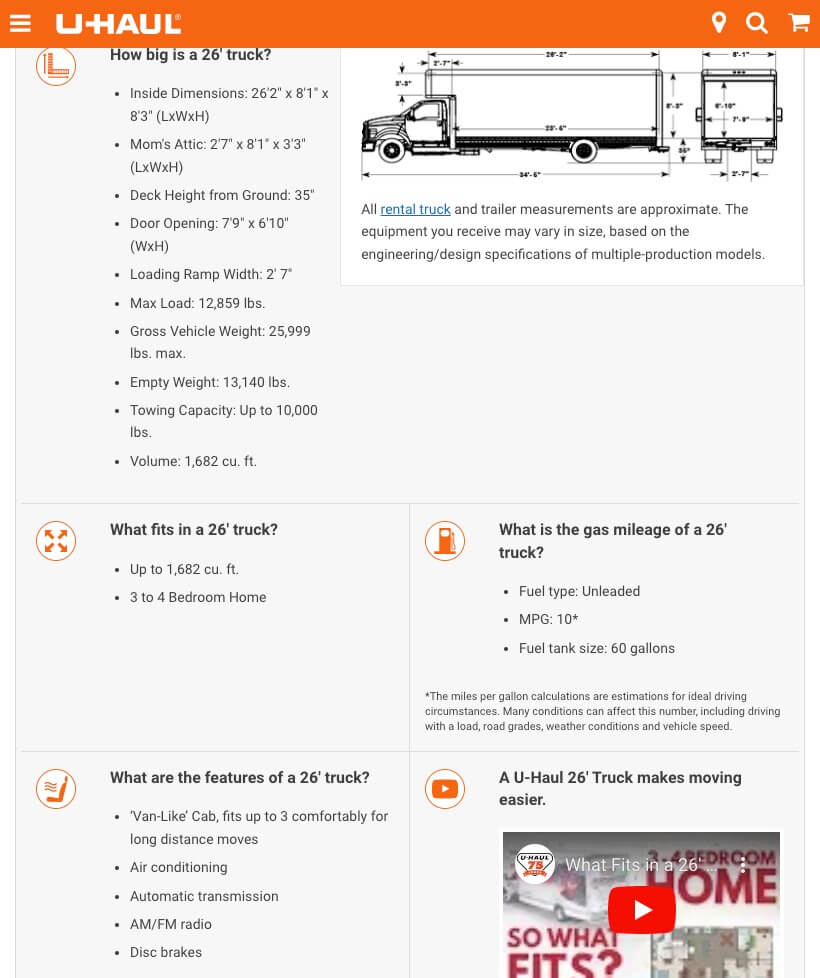U-Haul Truck Rental Fees: A Comprehensive Guide to Understanding Your Moving Costs sale.truckstrend.com
Moving is often cited as one of life’s most stressful events, and for many, a significant portion of that stress comes from managing costs. When embarking on a do-it-yourself (DIY) move, U-Haul stands out as the most ubiquitous name in truck rentals. However, the seemingly straightforward process of renting a truck can quickly become complex when you factor in the myriad of associated costs. Understanding U-Haul Truck Rental Fees is not just about knowing the base price; it’s about meticulously dissecting every potential charge, from mileage and fuel to optional protection plans and equipment rentals.
This comprehensive guide aims to demystify U-Haul’s pricing structure, empowering you to budget accurately, avoid surprises, and make informed decisions for your next move. By breaking down each fee component, offering practical advice, and providing a clear overview, we’ll ensure you’re well-equipped to navigate the financial landscape of your U-Haul rental.
U-Haul Truck Rental Fees: A Comprehensive Guide to Understanding Your Moving Costs
Understanding the Core Components of U-Haul Pricing
At its heart, U-Haul’s pricing model is built on a few fundamental elements, though their application varies significantly depending on the type of rental.
1. Base Rental Rate: Local vs. One-Way
The initial fee you encounter is the base rental rate, which is heavily influenced by whether your move is local or one-way.
- Local Moves: These are typically priced on a daily rate, often advertised as a very low starting point (e.g., "$19.95 a day"). This rate covers the truck for a 24-hour period. The actual cost will depend on the truck size, and crucially, this low rate does not include mileage or fuel. You pick up and drop off the truck at the same U-Haul location.
- One-Way Moves: Designed for cross-town or cross-country relocations, one-way rentals are priced differently. Instead of a daily rate plus mileage, you pay a fixed rate that typically includes a set number of days and a mileage allowance. This rate is influenced by several factors:

- Truck Size: Larger trucks naturally command higher rates.
- Distance: The greater the distance between your pick-up and drop-off locations, the higher the rate.
- Demand: Peak moving seasons (summer, end of month) and popular routes will see higher prices.
- Availability: Limited truck availability in a specific area can drive up costs.
- Time of Year/Week: Weekends and holidays are generally more expensive.

2. Mileage Charges
This is where the advertised low daily rate for local moves starts to climb.

- Local Moves: For local rentals, you are charged a per-mile rate on top of the daily base rate. This rate can vary by location but typically ranges from $0.69 to $0.99 per mile. Even a seemingly short local move can quickly accumulate significant mileage, especially if you need to make multiple trips.
- One-Way Moves: As mentioned, one-way rentals usually include a pre-determined mileage allowance within the fixed rate. It’s crucial to know this allowance. Exceeding it will incur an additional per-mile charge, which can be substantial.
3. Fuel Costs
Fuel is arguably the most overlooked and potentially expensive component of a U-Haul rental.
- Renter’s Responsibility: Unlike personal vehicles, U-Haul trucks are typically returned with the same fuel level as when picked up. If you pick up a truck with a quarter tank, you are expected to return it with a quarter tank.
- Penalty for Under-Fueling: Failing to return the truck with the required fuel level will result in U-Haul charging you for the missing fuel at a premium price per gallon, often significantly higher than pump prices, plus a refueling service fee. Always err on the side of caution and fill up before returning.
4. Environmental Fee
A small, non-negotiable fee, the environmental fee (typically around $1-$5) is added to every rental contract to cover costs associated with environmental compliance.
Additional Fees and Optional Costs to Consider
Beyond the core components, several other charges can significantly impact your total U-Haul bill. Being aware of these is key to accurate budgeting.
1. Damage Protection Plans
U-Haul offers various optional damage protection plans, primarily Safemove and Safemove Plus. These are designed to reduce your financial liability in case of damage to the rental truck or your cargo.
- Safemove: Covers damage to the U-Haul truck, cargo protection (loss or damage to your belongings), and medical/life coverage for the renter and passengers. It generally does not cover overhead damage or damage from hitting stationary objects.
- Safemove Plus: Offers more comprehensive coverage, including the exclusions from Safemove, and a higher level of medical/life coverage.
- Importance: While optional, it’s vital to check your personal auto insurance policy or credit card benefits to see if they cover rental trucks. Many personal policies do not cover vehicles of this size or type. Weighing the cost of protection against potential out-of-pocket expenses is a critical decision.
2. Towing Equipment
If you plan to tow a vehicle behind your U-Haul truck, you’ll need additional equipment.
- Auto Transport: A two-axle trailer that lifts all four wheels of your towed vehicle off the ground. More expensive but offers better protection for your vehicle.
- Car Dolly: A two-wheel trailer that lifts the front wheels of your towed vehicle off the ground, with the rear wheels remaining on the pavement. More affordable but puts wear and tear on your towed vehicle’s rear tires.
- Tow Dolly: (Less common for vehicles, more for smaller items).
- Fees: These are separate rental fees, added daily or for the duration of a one-way trip, and are dependent on the type of equipment and duration.
3. Moving Supplies
U-Haul offers a vast array of moving supplies for purchase, which are not included in the truck rental fee.
- Boxes: Various sizes and types.
- Packing Materials: Tape, bubble wrap, packing paper.
- Furniture Pads: Essential for protecting furniture (can be rented or purchased).
- Dollies: Appliance dollies, utility dollies (can be rented or purchased).
- Straps and Tie-downs: For securing cargo.
- Impact: While convenient, purchasing all your supplies from U-Haul can significantly inflate your total moving budget. Consider sourcing some items elsewhere or reusing materials.
4. Labor Services (Moving Help® & U-Box®)
While not directly part of the truck rental fee, U-Haul also facilitates additional services that some renters opt for.
- Moving Help®: A marketplace where you can hire local labor to help with loading, unloading, or even packing. These are third-party services, and their fees are separate from your truck rental.
- U-Box®: Portable moving and storage containers. If you use a U-Box, there are separate rental and transportation fees.
5. Late Return Fees
Returning your truck past the agreed-upon time can result in penalties. U-Haul may charge hourly or daily late fees, which can quickly add up. Always aim to return the truck on time or communicate with U-Haul if you anticipate delays.
6. Cleaning Fees
If the truck is returned excessively dirty, U-Haul reserves the right to charge a cleaning fee. Ensure the truck is swept out and free of debris.
7. Cancellation Fees
Canceling a reservation, especially last-minute, can sometimes incur a fee, though U-Haul generally has a flexible cancellation policy if done well in advance. Always check the specific terms of your reservation.
How U-Haul Calculates One-Way Rental Fees
The calculation for one-way rentals is more complex than local rentals, as it’s a dynamic pricing model similar to airline tickets or hotel bookings.
- Factors Influencing Price:
- Origin and Destination: The specific U-Haul locations you choose.
- Distance: The number of miles between these points.
- Truck Size: Larger trucks cost more.
- Date of Pick-up: Prices fluctuate based on the day of the week, month, and season. Peak moving season (late spring through summer) will always be more expensive.
- Availability: If there’s high demand for trucks going from your origin to your destination, or low availability at your destination, prices will be higher. Conversely, if U-Haul needs to move inventory, you might find a cheaper "repositioning" rate.
- Included Allowance: The fixed rate for a one-way rental typically includes a specific number of days for the rental and a set mileage allowance. For example, a 1,000-mile move might come with 4 days and 1,100 miles included.
- Penalties: Exceeding the allotted days or miles will incur additional charges, which can be significant. Always plan your route and schedule carefully.
Tips for Saving Money on U-Haul Rentals
While U-Haul fees can accumulate, strategic planning can help you keep costs down.
- Book in Advance: Especially for one-way moves and during peak season, booking several weeks or even months ahead can secure a better rate and ensure truck availability.
- Be Flexible with Dates & Locations: If your schedule allows, try to move mid-week or mid-month. Sometimes, picking up or dropping off at a slightly different U-Haul location (a few miles away) can result in a lower rate.
- Choose the Right Truck Size: Don’t overpay for space you don’t need, but also don’t under-estimate and have to make multiple trips (for local moves) or rent a second truck. Use U-Haul’s size guide tools.
- Pack Efficiently: Maximize the space in the truck to avoid needing a larger vehicle or making extra trips.
- Return on Time and with Proper Fuel: Adhere strictly to the return time to avoid late fees. Always refuel the truck to the required level before returning it to avoid premium fuel charges and service fees.
- Understand Insurance Options: Check your personal auto or homeowner’s insurance for coverage before opting for U-Haul’s protection plans. If your personal policy doesn’t cover it, Safemove or Safemove Plus might be a worthwhile investment for peace of mind.
- Consider DIY Moving Supplies: While U-Haul sells everything, you might find cheaper boxes at local stores, grocery stores, or online marketplaces. Renting furniture pads instead of buying can also save money.
- Look for Discounts/Promotions: Check U-Haul’s website for any ongoing promotions or seasonal discounts.
Potential Challenges and Solutions
Even with careful planning, challenges can arise.
- Unexpected Mileage Overages:
- Challenge: Miscalculating distance for local moves, or underestimating side trips for one-way moves.
- Solution: Use online mapping tools (like Google Maps) to meticulously plan your route and estimate total mileage for local moves. For one-way moves, stick strictly to the most direct route.
- Fuel Cost Surprises:
- Challenge: Underestimating fuel consumption, or forgetting to refuel.
- Solution: Familiarize yourself with the truck’s fuel capacity and average MPG. Factor fuel costs into your budget. Always fill up just before returning the truck. Take a picture of the fuel gauge upon pickup and drop-off.
- Availability Issues:
- Challenge: Not being able to get the desired truck size or pick-up/drop-off location, especially during peak season.
- Solution: Book as far in advance as possible. Be flexible with your dates and consider slightly less convenient locations. Have a backup plan (e.g., a different rental company) if possible.
- Damage Claims:
- Challenge: Being held liable for damage you didn’t cause, or unexpected costs for accidental damage.
- Solution: Thoroughly inspect the truck before driving away. Take photos or videos of any existing damage (inside and out) and ensure it’s noted on your contract. Consider a protection plan if your personal insurance doesn’t cover it.
Estimated U-Haul Truck Rental Fees Price Table
Disclaimer: These are estimates only. Actual prices vary drastically based on location, demand, time of year, and specific U-Haul promotions. Always get a direct quote from U-Haul for your specific needs.
| Truck Size | Local Daily Rate (Est.) | Local Mileage Rate (Est.) | One-Way Base Rate (Est. Range) | Safemove (Est. per day) | Safemove Plus (Est. per day) | Environmental Fee (Fixed) |
|---|---|---|---|---|---|---|
| 8′ Pickup | $19.95 – $29.95 | $0.79 – $0.99/mile | N/A (Local Only) | $14.00 – $18.00 | $20.00 – $25.00 | $1.00 – $5.00 |
| 9′ Cargo Van | $19.95 – $29.95 | $0.79 – $0.99/mile | N/A (Local Only) | $14.00 – $18.00 | $20.00 – $25.00 | $1.00 – $5.00 |
| 10′ Truck | $19.95 – $29.95 | $0.79 – $0.99/mile | $120 – $1,500+ | $14.00 – $18.00 | $20.00 – $25.00 | $1.00 – $5.00 |
| 15′ Truck | $29.95 – $39.95 | $0.79 – $0.99/mile | $150 – $2,000+ | $18.00 – $25.00 | $25.00 – $35.00 | $1.00 – $5.00 |
| 17′ Truck | $29.95 – $39.95 | $0.79 – $0.99/mile | $180 – $2,500+ | $18.00 – $25.00 | $25.00 – $35.00 | $1.00 – $5.00 |
| 20′ Truck | $39.95 – $49.95 | $0.79 – $0.99/mile | $200 – $3,000+ | $20.00 – $30.00 | $30.00 – $40.00 | $1.00 – $5.00 |
| 26′ Truck | $39.95 – $49.95 | $0.79 – $0.99/mile | $250 – $4,000+ | $25.00 – $35.00 | $35.00 – $45.00 | $1.00 – $5.00 |
Note on One-Way Base Rate: This range is extremely broad because it depends heavily on distance (e.g., 100 miles vs. 2,000 miles), demand, and availability. A short one-way move might be on the lower end, while a cross-country move in peak season for a large truck will be on the higher end.
Frequently Asked Questions (FAQ)
Q1: How is mileage calculated for local U-Haul moves?
A1: For local moves, you pay a fixed daily rate for the truck, plus a per-mile charge for every mile driven. The mileage is tracked by the odometer from when you pick up the truck until you return it.
Q2: Do I need to return the U-Haul truck full of gas?
A2: You need to return the truck with the same fuel level as when you picked it up. If you return it with less fuel, U-Haul will charge you for the missing fuel at a premium rate, plus a refueling fee.
Q3: What happens if I return the U-Haul truck late?
A3: Returning the truck late can result in additional charges. U-Haul typically charges hourly or daily late fees. It’s best to contact them immediately if you anticipate being late to avoid unexpected costs.
Q4: Is insurance included in the U-Haul rental fee?
A4: Basic liability coverage is typically included to meet minimum legal requirements, but comprehensive damage protection for the truck or your cargo is not. U-Haul offers optional protection plans (Safemove, Safemove Plus) that you can purchase for additional coverage. It’s crucial to check your personal insurance policies before opting in.
Q5: Can I pick up and drop off the U-Haul truck at different locations?
A5: Yes, this is a "one-way" rental. U-Haul specializes in one-way moves, allowing you to pick up a truck in one city and drop it off in another. These rentals have a fixed rate that includes a set number of days and miles.
Q6: Are there any hidden fees with U-Haul?
A6: While U-Haul aims to be transparent, some fees can feel "hidden" if you’re not aware of them. These often include mileage charges (for local moves), premium fuel charges if you don’t refuel, late return fees, and costs for optional items like damage protection, dollies, or moving blankets. Always get a detailed quote and read your contract carefully.
Q7: How far in advance should I book my U-Haul truck?
A7: For local moves, a few days to a week might suffice. For one-way moves, especially during peak moving season (May-August) or at the end/beginning of the month, it’s highly recommended to book 3-4 weeks in advance, or even earlier for cross-country moves, to ensure availability and potentially better rates.
Conclusion
Navigating U-Haul Truck Rental Fees requires diligence and an understanding of the multifaceted cost structure. What might initially appear as a low base rate can quickly escalate with mileage, fuel, optional protection, and additional equipment. By meticulously planning your move, understanding the distinction between local and one-way pricing, factoring in all potential charges, and leveraging the money-saving tips outlined in this guide, you can gain significant control over your moving budget.
U-Haul remains an indispensable tool for DIY movers, offering flexibility and accessibility. With this comprehensive knowledge, you’re not just renting a truck; you’re making an informed investment in a smoother, more predictable moving experience. Budget wisely, move confidently, and make your next relocation a financial success.




